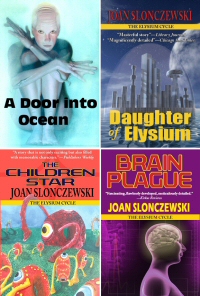RNA origin of Early Life
How did life on Earth first arise out of the chemical soup? According to Nobelist Jack Szostak, it began with a self-replicating RNA chromosome inside a lipid bubble. It looks something like an HIV virus–and some people argue that “viruses” were the first cells. As the RNA made copies of itself, the bubble expanded. Szostak has accomplished several steps of this process in his own laboratory.
In Szostak’s model, the RNA chain carries information including a means to copy itself. The copying mechanism must allow occasional errors, so that new sequences arise that encode new useful functions. The new functions can be inherited and can further evolve. The protocell membrane then keeps these chains of RNA in one place, so that the functions they encode confer an advantage for their own survival and propagation.
Could this RNA world arise by chance? What other problems must be solved to have a genuine life form?
Comments are closed.



some people argue that “viruses” were the first cells
Isn’t the evidence accumulating that viruses evolved from cells?
Could this RNA world arise by chance?
If we posit an RNA world that is primarily metabolic, then according to Stuart Kaufman it is potentially certain given enough different components. My understanding is that RNA polymers are not energetically favorable, so that getting them is unlikely by the means we have explored to date. What we need is some sort of mechanism where RNA polymers are built up in length rather than break up into nucleotides. Finally, what stimulated the move from RNA to proteins as the main functional components of a cell?
There are three models for virus evolution–each supported by strong evidence from different viruses. Viruses are so diverse that I think different ones are completely different kinds of “creature.”
(1) Viruses evolved from cells–Yes, the Mimivirus, pox viruses, and herpes viruses most likely evolved from cells. They are DNA viruses with large genomes, enzymes, and cell-like membranes.
(2) Viruses evolved from cell parts–HIV, whose reverse polymerase enzymes (RNA to DNA) looks like it evolved from telomerase, the enzyme that completes replication of chromosome ends (telomeres).
(3) Viruses came first, then evolved into cells. HIV and other retroviruses with RNA enclosed by a membrane, like the first step of Szostak’s model. Also, RNA viroids (self-cleaving RNA) such as hepatitis delta look like RNA that could have been a self-replicator in the “soup.”
It’s important though to remember that no virus today would look exactly like the original replicator proto-cells, because evolution has generated more competitive versions a million times over.
Is RNA condensation energetically favorable? That depends on the conditions. With electrical storms, you would have continual bursts of energy that could be absorbed by reactions building nucleotides and condensing them. Perhaps the earliest life form “ate” lightning.
Interesting idea, Luke—I don’t know ahntniyg about yeast’s baseline abilities in this regard, but it’d make sense that if you provided iron in the growth medium, then selected “survivor” colonies using a magnet as you suggest, eventually you’d get a strain that was really good at accumulating iron.
My biggest concern over the origins of life is the ribosome: Such a complex piece of chemical machinery, with both protein and RNA components, that’s needed to start encoding RNA into proteins. It’s pervasive in earthly lifeforms with minimal differences, and seems even harder to be a chance creation than self-replicating RNA strands. Seeding a planet with a single-celled organism that uses the ribosome seems more likely than chance evolution.
Where did proteins come from, as you and Alex ask?
There is a fascinating body of work by Harold Morowitz among others that attempts to “connect the dots” from RNA through amino acids and peptide chains. Morowitz traces chemical continuities between nucleotides and the earliest amino acids; the ones that form spontaneously in the “soup” with electric discharge, and are also found in meteorites.
Also, it can be shown that the “oldest” amino acids (alanine, glycine, proline) use codons that depend only on two nucleotides (G, C permutations). Most microbiologists agree that the earliest genetic code had only two letters, not three. Perhaps there were three stages: two-letter (GC only, 4 codons); two-letter (GCAT, 16 codons); three-letter (GCAT, 64 codons).
The ribosome is actually an RNA machine. All the catalysis is done by the RNA components. The ribosomal proteins look mainly like stabilizers.
It seems that most theories about how life began tend to focus on only one very linear path which is odd considering the variety of different families of life that are still around. Personally I prefer a stochastic approach similar to those considered to have formed the planet Earth. The stochastic process also allows for one-of events together which can trigger near-instantaneous changes. For example, comets contain amino acids, and even if these are only l-amino acids racemization will occur providing ‘new’ amino acids that given enough time will further change/split to provide more chemical fodder thereby providing a larger base of ingredients in type and complexity thus reducing the number of steps needed to create ever larger, more complex molecules from available chemical inventory.
You’re right that most textbook presentations of life’s origin are linear; one tree trunk with lots of branches. But what about all those roots below ground?
Modern models by microbiologists look a lot more like the tree with roots. We think a whole range of different versions of “life” arose, then mingled their components in various ways. But at some point a particularly successful version overtook the rest; we know that since all life forms (except viruses) possess ribosomes that are homologous (share an ancestor). That can still include lots of other ancestral roots we don’t know about, but at least one lineage is common to all extant forms today.
I’m looking forward to the day that a similar study discovers that ribosomes (or some other major evolutionary step) arose independently more than once and via different paths in an ‘all roads lead to Rome’ kind of way.
Biologists Replicate Key Evolutionary Step
…
“To understand why the world is full of plants and animals, including humans, we need to know how one-celled organisms made the switch to living as a group, as multicelled organisms,” said Sam Scheiner, program director in the National Science Foundation (NSF)’s Division of Environmental Biology. “This study is the first to experimentally observe that transition, providing a look at an event that took place hundreds of millions of years ago.”
….
“Evolutionary biologists have estimated that multicellularity evolved independently in about 25 groups. Travisano and Ratcliff wonder why it didn’t evolve more often in nature, since it’s not that difficult to recreate it in a lab. Considering that trillions of one-celled organisms lived on Earth for millions of years, it seems as if it should have, Ratcliff said.”
http://www.sciencedaily.com/releases/2012/01/120117144330.htm
Journal Reference:
1. William C. Ratcliff, R. Ford Denison, Mark Borrello, and Michael Travisano. Experimental evolution of multicellularity. Proceedings of the National Academy of Sciences, January 17, 2012 DOI: 10.1073/pnas.1115323109
If you count so-called microbial groups (which multicellular biologists usually neglect) then multicellularity has evolved hundreds of times, in fungi, slime molds, streptomycetes, etc. And I’m sure yeast-forms evolve back and forth in nature.
Also, even if you just count those 25 groups, whatever they are, you can be sure that far more evolved eventually; the remaining lineages would be the most successful ones. Diversity gets lost over time, in all systems.